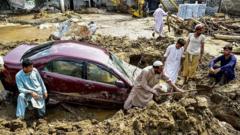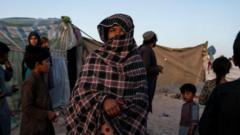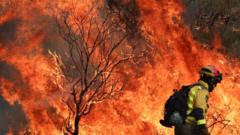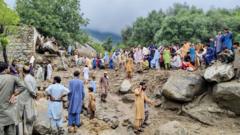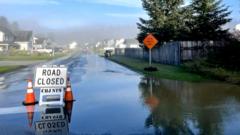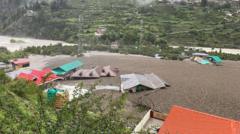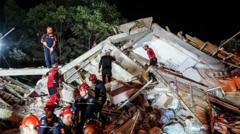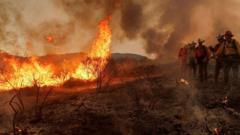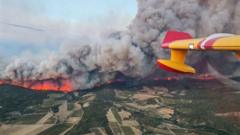**The recent heavy rains in Pakistan have led to devastating floods and landslides, claiming over 300 lives and prompting urgent rescue efforts as communities face the aftermath of this disaster.**
**Deadly Flash Floods Strike Pakistan and Administered Kashmir, Resulting in Over 300 Casualties**
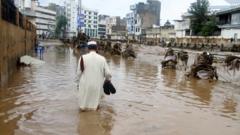
**Deadly Flash Floods Strike Pakistan and Administered Kashmir, Resulting in Over 300 Casualties**
**A devastating monsoon season causes widespread destruction while communities grapple with loss.**
In the wake of relentless monsoon floods and landslides, the death toll in Pakistan and Pakistan-administered Kashmir has tragically risen to at least 307. Most fatalities have been reported in the northwestern province of Khyber Pakhtunkhwa, where disaster management officials note significant damage, including the destruction of at least 74 homes.
The extreme weather has also led to grave incidents such as the crash of a rescue helicopter that claimed the lives of its five crew members due to treacherous conditions. Authorities in Pakistan-administered Kashmir have recorded nine additional fatalities, with five more casualties reported from the northern region of Gilgit-Baltistan.
Weather forecasts predict continuing heavy rain in the northwest until August 21, with extensive areas already classified as disaster zones. A survivor from Buner recounted the shocking arrival of the floods, describing it as a "doomsday." He recalled the terrifying sounds of collapsing mountains and the ground trembling with the massive force of the water.
Khyber Pakhtunkhwa's Chief Minister, Ali Amin Gadapur, emphasized the impact of the helicopter crash during rescue operations in Bajaur, a border area with Afghanistan. Amid the devastation, mourners gathered to pay their respects in various locations, with Khyber Pakhtunkhwa declaring a day of mourning for its lost citizens.
In the Indian-administered region of Kashmir, emergency teams are recovering bodies from a village submerged by floods, with the initial toll reaching at least 60, as rescuers continue their search through mud and debris.
This year's monsoon rains, which typically persist from June to September, account for around 75% of South Asia's annual precipitation. With severe flooding and landslides commonplace, a staggering total of 650 fatalities has been linked to this year's floods. Recent data shows that the Punjab province, home to a significant portion of Pakistan's population, has experienced a 73% increase in rainfall compared to the previous year, resulting in even higher casualty numbers.
Experts attribute the intensity of recent weather patterns to climate change, which continues to heighten the effects of monsoon rains by destabilizing susceptible mountain environments. The impact of melting glaciers in northern Pakistan further complicates the situation, increasing the risk of debris flows and landslides. Although the precise causes of the current floods are still under evaluation, glaciologists are raising concerns about the influence of ice melt on these extreme weather events.
The extreme weather has also led to grave incidents such as the crash of a rescue helicopter that claimed the lives of its five crew members due to treacherous conditions. Authorities in Pakistan-administered Kashmir have recorded nine additional fatalities, with five more casualties reported from the northern region of Gilgit-Baltistan.
Weather forecasts predict continuing heavy rain in the northwest until August 21, with extensive areas already classified as disaster zones. A survivor from Buner recounted the shocking arrival of the floods, describing it as a "doomsday." He recalled the terrifying sounds of collapsing mountains and the ground trembling with the massive force of the water.
Khyber Pakhtunkhwa's Chief Minister, Ali Amin Gadapur, emphasized the impact of the helicopter crash during rescue operations in Bajaur, a border area with Afghanistan. Amid the devastation, mourners gathered to pay their respects in various locations, with Khyber Pakhtunkhwa declaring a day of mourning for its lost citizens.
In the Indian-administered region of Kashmir, emergency teams are recovering bodies from a village submerged by floods, with the initial toll reaching at least 60, as rescuers continue their search through mud and debris.
This year's monsoon rains, which typically persist from June to September, account for around 75% of South Asia's annual precipitation. With severe flooding and landslides commonplace, a staggering total of 650 fatalities has been linked to this year's floods. Recent data shows that the Punjab province, home to a significant portion of Pakistan's population, has experienced a 73% increase in rainfall compared to the previous year, resulting in even higher casualty numbers.
Experts attribute the intensity of recent weather patterns to climate change, which continues to heighten the effects of monsoon rains by destabilizing susceptible mountain environments. The impact of melting glaciers in northern Pakistan further complicates the situation, increasing the risk of debris flows and landslides. Although the precise causes of the current floods are still under evaluation, glaciologists are raising concerns about the influence of ice melt on these extreme weather events.

